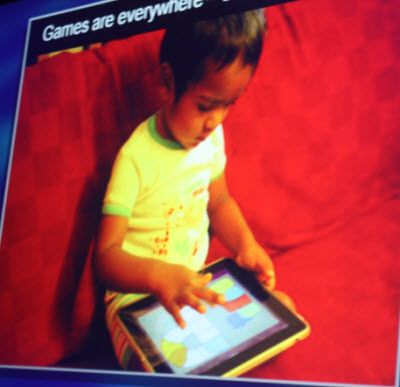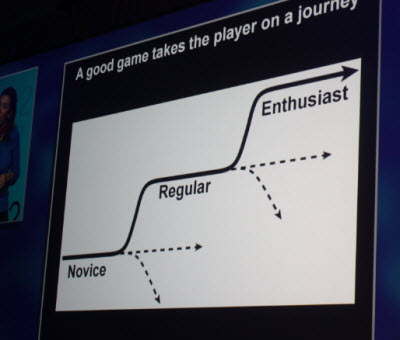GamesBeat:设计师Amy Jo Kim谈游戏化设计7大技巧
游戏邦注:游戏设计元老Amy Jo Kim日前在旧金山Web 2.0 Expo上谈到了游戏化设计的7大技巧。本文将详阐述相关内容。Kim曾参与EA《模拟人生》和《网络创世纪》的制作,同时还曾帮助eBay、网飞(Netflix)和Rock Band设计类似游戏的体验,她未来几周内将会成立自己的游戏化工作室。
游戏化就是将类似游戏的机制添加到非游戏应用中,达到增加用户粘性的目的,其目前备受业内人士的追捧。游戏邦获悉,游戏化高手Amy Jo Kim对此也颇为关注,她日前在旧金山Web 2.0 Expo上论述了7大游戏化核心技巧。
Kim是游戏设计元老,同时也是Shufflebrain工作室的创始人,她称自己并不喜欢“游戏化”一词,她更偏好“游戏思考”,她认为游戏未来将无处不在。游戏设计师Will Wright将未来这一时代比作Gambrian Explosion,就像5亿年前,寒武纪生命大爆发(Cambrian Explosion)涌现了众多全新生命形态。
Kim表示,很多人将游戏化形容为类固醇忠诚计划;利用游戏技巧持续提高产品、服务和应用的价格;把现实生活的活动转化到游戏中。但游戏思考鲜有浮夸成份,更多的是实质内容,游戏思考就是分享游戏设计师所懂知识。
以下7大观点的详细内容:
1.了解体验对象
依照他们的社交方式设计体验内容。人们的娱乐方式纷繁复杂,但他们的体验风格是什么呢?他们是否极具求胜心理,喜欢打败对手,然后夸耀一番?用户热衷探索吗?用户是否具有合作精神或者体验内容只是为了自我表现?游戏邦发现,这些因素都会影响游戏或者服务的核心内容。
2.在核心体验环节融入趣味、快乐和满足感
许多批评人士认为《FarmVille》毫无游戏性可言。但Kim认为其核心活动实际上很有趣。玩家种植庄稼,照看其成长,然后获得劳动的美好果实,享受这一回报。Foursquare也推出了积极的体验内容,其地理定位游戏十分有趣,帮助玩家了解周边环境,同时游戏极具社交性。游戏邦发现,就连亚马逊网站都有核心体验环节,用户点击某商品后,就可获得商品的相关信息,且购买商品后,还会收到交易成功的确认。亚马逊给予用户积极的体验,博得用户信赖,放心在平台进行金钱交易。
3.用户体验与时俱进
玩家体验周期有3大关键阶段:新手、常客和忠实粉丝。他们并非一成不变地访问网站,体验游戏或者进行其他活动。他们需要不同的内容来实现满足感。Foursquare利用分数和徽章来代表玩家晋升的不同等级。新手需要新鲜的内容、活动和挑战。忠诚粉丝需要专属奖品、认可和影响力。
4.创建易学但难精通的系统
我们可以参照Quora问答网站之类的应用。提出问题或者解读答案对用户来说并不困难。其他用户可以修改某个用户所提问题,从而获得更好的答案。而该用户也可以从中学习如何更好问问题。游戏邦认为最终问题的质量也将得到提高。Quora让用户学会如何问答。
5.游戏机制推动用户掌握知识
Nike+Coach项目训练用户跑步。程序为用户掌握长跑技巧提供清晰反馈和渐进目标,并在社区内分享用户信息,让用户明白数据的意义,并为用户提高自我指明方向。
6.随着玩家的进步,提高体验的挑战性和复杂性
这在游戏设置中被称作“流动”,游戏设置用来吸引用户,消除焦虑和乏味感。设计师得确保用户处在中间位置,或者流动渠道,这可以通过提供渐进式的任务道具来实现。游戏邦发现,用户在《CityVille》之类的游戏中每晋升一级,就会出现更多的任务。设计师可以将游戏老将的用户界面变得更复杂,为他们提供新道具。
7.融入内在刺激因素
Dan Pink在其作品《Drive: The Surprising Truth About What Motivates Us》中谈到了内在激励和外在激励。从很多方面来看,固有价值比外部激励更胜一筹。设计师可以通过刺激用户的内在动机来促使他们完成任务,内在动机带给用户真正的价值。Modcloth为用户提供创造大众品牌的机会,这给予用户的是满足感,而非外部激励。(本文为游戏邦/gamerboom.com编译,转载请注明来源:游戏邦)
The seven tricks everyone can learn from game designers
Gamification, the practice of adding game-like mechanics to non-game applications to improve engagement, is going through a hype cycle. And one of its leading experts, Amy Jo Kim, added to the push by outlining seven core gamification tricks today at the Web 2.0 Expo in San Francisco.
Kim, a veteran game designer and founder of the game studio Shufflebrain, said she wasn’t a fan of the word “gamification.” She prefers the word “game thinking” and believes that games are going to be everywhere, noting that game designer Will Wright refers to this time as a Gambrian Explosion, much like the Cambrian Explosion that gave birth to so many new life forms 500 million years ago. Games are everywhere.
Kim said that some people describe gamification as a loyalty program on steroids; or using game techniques to turbo-charge products, services and apps; or taking a real world activity and turning it into a game. But game thinking cuts through the hype and is a more important story. It’s about teaching what game designers know that everybody else should know.
Here are the seven ideas explained:
1. Know who’s playing – design for their social style. There are a lot of different ways to entertainment people. What is their style of playing? Are they so competitive that they like to beat their opponents and brag about it? Is the audience into exploration? Is the gamer cooperative, or playing for the sake of self-expression? These considerations will affect the core actions in the game or service.
2. Build fun, pleasure, and satisfaction into your core activity loop. Many critics felt that FarmVille had no game play. But Kim said the core activity actually was fun. You planted crops, watched them grow, harvested the beautiful fruits of your labor, and enjoyed rewards. Foursquare also creates positive emotions, since the location-based game is fun, useful in terms of educating you about your surroundings, and it’s social. Even Amazon has a core activity loop where you click on something, get immediate information about it, then you buy it and receive assurance that the transaction has gone through. Amazon imparts a positive emotion that makes you feel like you can trust it with your money transactions.
3. Change the user experience over time. There are three key stages of a player’s life cycle: novice, regular, and enthusiast. They won’t experience a web site, game or other experience in a static way. They need different content to be satisfied. Foursquare uses points and badges for leveling up. Regulars need fresh content, activities and challenges. Enthusiasts need exclusive rewards, recognition, and impact.
4. Build a system that’s easy to learn but hard to master. You can look at applications such as Quora, the question and answer site. It’s easy to figure out how to ask questions or read answers. Other users can edit your questions so they will get better answers. You can learn from their example how to write better questions. The quality of the questions goes up. Quora can teach people how to master the question and answer process.
5. Use game mechanics to light the way towards mastery. The Nike + Coach program trains users how to run. It offers clear feedback and progressive goals that show you how to master long-distance running, share your stats with the community, and understand what your stats mean. It shows you the path to get better.
6. As players progress, increase the challenge and complexity. This is called “flow” in game play, where you try to keep the player interested in the experience, balancing between anxiety and boredom. You have to keep the gamer in the middle, or the flow channel. You can do this with progressive quests, which give you more tasks to do once you’ve leveled up in games like CityVille. You can make the user interface more complex after someone masters the game and give the users new tools when they are ready for them.
7. Embrace intrinsic motivators. A book by Dan Pink — Drive: The Surprising Truth About What Motivates Us — tells about intrinsic rewards and extrinsic rewards. Intrinsic value trumps extrinsic rewards in many ways. You can get your user to complete tasks by stirring their intrinsic motivations that deliver real value to players. Modcloth lets users create a crowdsourced clothing line that gives people who create it a lot of satisfaction, but not a huge external reward.
Kim has worked on games such as The Sims and Ultima Online for Electronic Arts and she has helped design game-like experiences for eBay, Netflix, and Rock Band. She is holding her own gamification workshops in the coming weeks.(Source:GamesBeat)











































 闽公网安备35020302001549号
闽公网安备35020302001549号